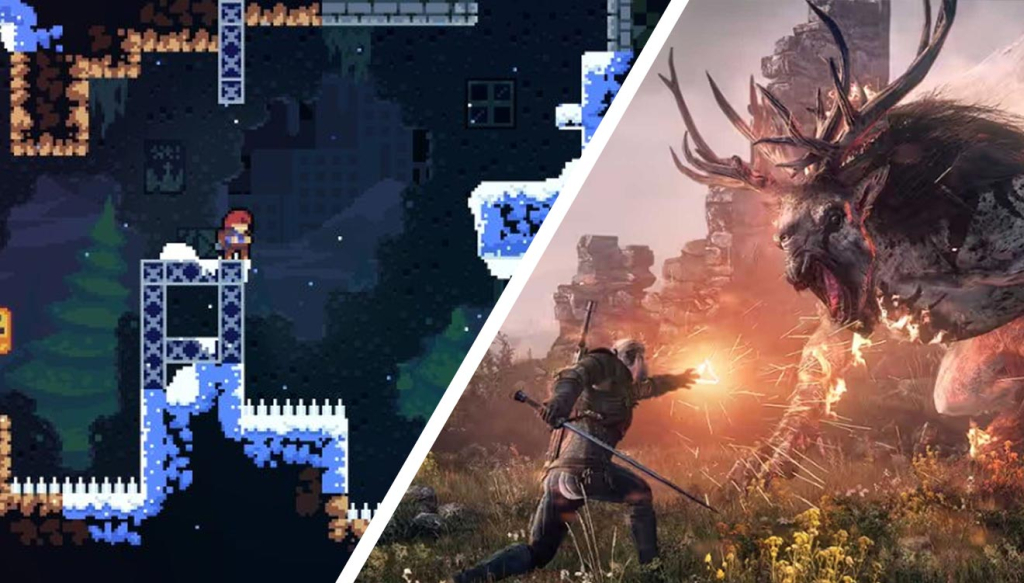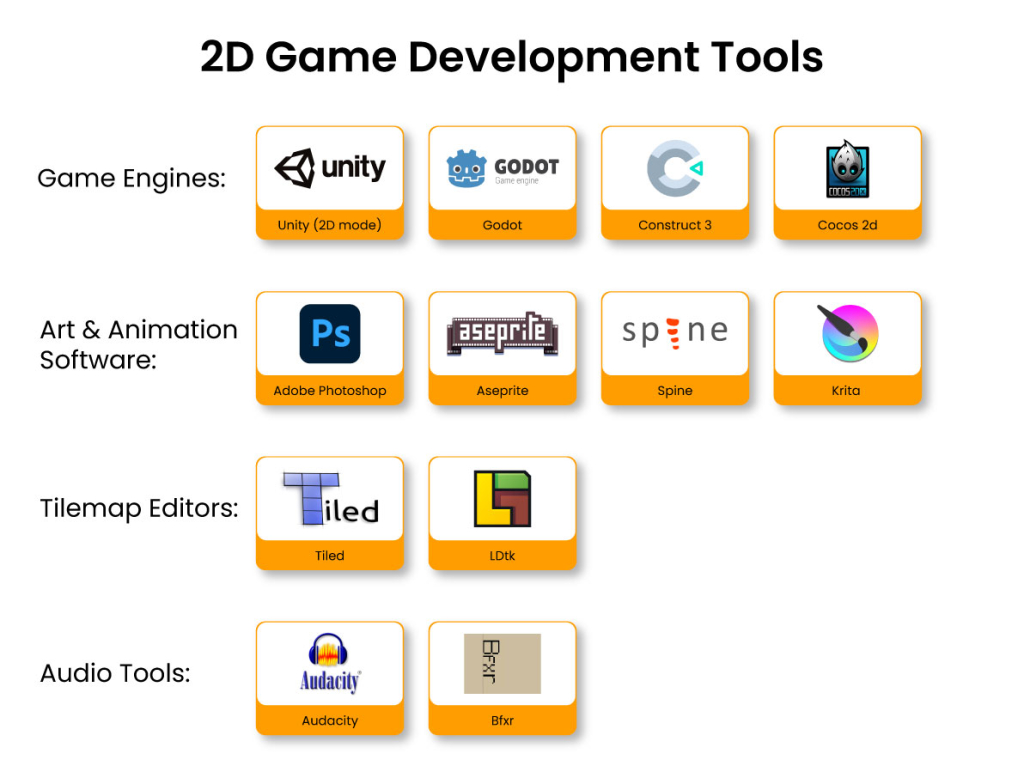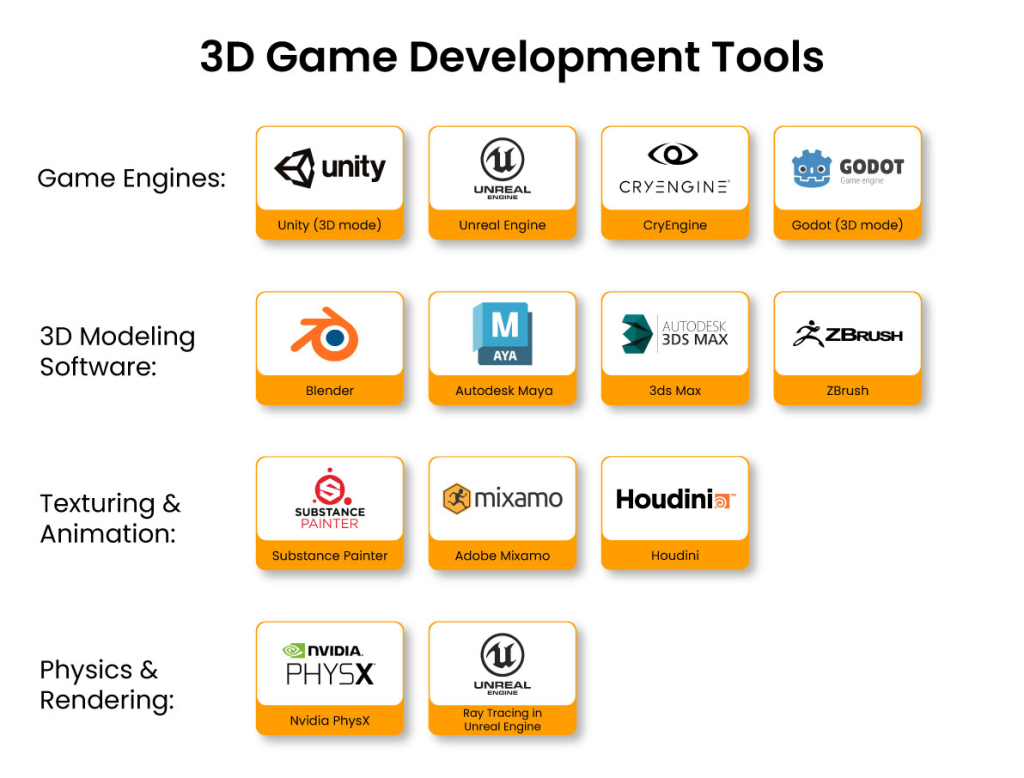Table of Contents
One of the first decisions you’ll need to make regarding game development is whether to go with 2D or 3D. Both have their strengths, but understanding the differences between 2D & 3D game development can help you choose the best approach for your project. In this guide, we’ll explore the unique features, benefits, and challenges of both, from design principles to technology and cost considerations.
The evolution of video game technology has led to the emergence of two main development styles: two-dimensional (2D) vs three-dimensional (3D) designs. Each of these approaches offers its own set of features, challenges in implementation, and creative opportunities in the world of interactive entertainment.
Two-dimensional games often connect with players due to their easy accessibility and unique visual charm, rooted in classic gaming traditions. This format remains popular thanks to efficient development methods and a clear focus on gameplay mechanics. On the other hand, three-dimensional games captivate audiences with their intricate environments and rich spatial interactions, utilizing cutting-edge technology to craft immersive experiences.
In this guide, we will delve into the history, differences, and key aspects of 2D & 3D game development to help you navigate the complexities of these formats.
Two-dimensional gaming laid the groundwork for modern interactive entertainment. The launch of Tennis for Two in 1958 signaled the start of a new era, which gained immense popularity in the 1970s and 1980s with iconic titles such as Space Invaders, Pac-Man, and Super Mario Bros. The simplicity of two-dimensional design made it easy for both developers and players to embrace. Even with technological advancements leading to three-dimensional graphics, two-dimensional gaming has resurgent, especially among indie developers, who appreciate its unique visual charm and lower production costs.
The evolution of three-dimensional gaming began in the 1970s with groundbreaking titles like Maze War and Spasim. By the 1990s, significant technological progress made 3D graphics the norm in the industry, highlighted by landmark games such as Super Mario 64 and Quake, which changed how players experienced immersion. Today, three-dimensional gaming is at the forefront of major commercial projects, offering unmatched visual realism and expansive environments.
Game development is a multifaceted process, and the choice between 2D vs 3D games can significantly influence various aspects of a project. Below, we explore the significant differences in detail, covering graphics, mechanics, resources, and more.
Art Style: Two-dimensional games mainly utilize sprite graphics and tile designs. This encompasses pixel art, classic hand-drawn animations, and vector graphics. Although this method allows for a wide range of artistic creativity, it does come with challenges in depicting spatial depth.
Animation: The animation in 2D games primarily uses frame-by-frame techniques or simplified skeletal animation with fewer frames. This approach creates a unique visual style but requires creative solutions to achieve fluid motion.
Examples: Iconic games like Super Mario Bros. and modern indie titles such as Celeste showcase the vast creative potential found within 2D art styles.

Art Style: Three-dimensional games utilize polygon-based modeling techniques enhanced by texture mapping to add surface detail. The visual styles range from photorealistic designs to more stylized methods, including cel-shaded rendering.
Animation: In 3D animation, skeletal rigging systems work alongside physics simulation engines to create realistic movement. This setup allows for advanced character animations but requires more technical skill and development resources.
Examples: Modern titles like The Witcher 3 and Fortnite showcase the rich narrative potential that can be realized through three-dimensional graphics.
Movement Plane: In this type of gameplay, character movement is restricted to a simple coordinate system that only utilizes the X and Y axes. This constraint makes the mechanics more straightforward to grasp while enabling the creation of intricate levels that test players’ timing and navigation abilities.
Platforming Elements: Platforming plays a crucial role in 2D games, demanding that players execute precise jumps, scale obstacles, and avoid dangers as they move along a set path.
Examples: Iconic titles like Sonic the Hedgehog highlight the importance of speed management and accurate control within confined areas.

Three-Dimensional Movement: Players can move in any direction along the X, Y, and Z axes, which allows for thorough exploration of their environment and numerous interaction possibilities.
Camera Control: Many 3D games incorporate sophisticated systems automatically tracking the player’s movements or permitting manual viewpoint adjustments. This feature boosts immersion and adds depth to the gameplay design.
Examples: Expansive titles like Grand Theft Auto V offer vast worlds that invite players to explore without restrictions.
Control Schemes: In 2D games, the input setups are simplified, focusing on basic commands like moving, jumping, and attacking. This simplicity makes it easy for new players to jump right in, while still allowing for deeper gameplay through more complex combinations of actions.
Input Responsiveness: The straightforward control design ensures that inputs are registered consistently with minimal delay, especially compared to three-dimensional games’ more complex control schemes.
Examples: Games like Hollow Knight demonstrate how intuitive controls and responsive mechanics contribute to engaging gameplay.

Complex Controls: 3D games require more elaborate input systems that handle various functions simultaneously, such as movement using the WASD keys and camera control with the mouse. This added complexity means that new players face a steeper learning curve.
Precision Challenges: Moving around in three-dimensional spaces can be tricky, as it involves unique challenges related to spatial awareness and accurate control, particularly regarding character movement and operating vehicles.
Examples: Titles like Elden Ring showcase intricate control schemes that enhance immersion and strategic gameplay.
Resource Requirements: Developing a two-dimensional game requires fewer resources for creating artistic assets and programming structures. This setup allows for the development of high-quality products with smaller team sizes.
Development Speed: The inherent characteristics of two-dimensional graphics support faster prototyping and iterative development. Many independent developers prefer this method because it is more budget-friendly.
Examples: Popular indie games like Stardew Valley highlight how smaller teams can create impactful experiences with 2D game development.

Higher Resource Needs: Creating three-dimensional games demands larger teams with specialized skills like model creation, texture application, skeletal rigging, animation, and advanced programming. The need for complex asset development significantly affects both time and budget.
Longer Development Cycles: The complexity of building detailed three-dimensional environments can significantly extend development timelines, especially in large commercial projects.
Examples: Blockbuster games like Cyberpunk 2077 demonstrate the extensive resources required to deliver visually rich 3D worlds.
Gameplay Focused: Two-dimensional games primarily focus on mechanical interaction rather than striving for visual realism. The unique charm of 2D art lies in its ability to provide engaging experiences without the need for lifelike graphics.
Narrative Techniques: Story development usually unfolds through text-based dialogue or simple cutscenes rather than relying on heavily animated storytelling.
Examples: Games like Undertale emphasize storytelling and player engagement in 2D format.
Enhanced Immersion: Three-dimensional worlds allow for the creation of intricate interactive environments that enhance player involvement. Advanced physics and lighting technologies play a crucial role in making these settings feel more authentic.
Cinematic Experiences: Modern 3D games often feature elaborate narrative delivery, utilizing voice acting, motion-captured animations, and intricate storylines that evolve through player interactions.
Examples: Titles like Red Dead Redemption 2 set the benchmark for immersive storytelling in 3D environments.
Creative Freedom: Working in a two-dimensional space allows for a wide range of artistic exploration without complex technology. This approach fosters inventive mechanical designs that focus on essential visual elements.
Level Design Constraints: Although two-dimensional level design encourages creativity within flat boundaries, it demands careful planning to ensure a diverse and engaging experience, avoiding repetitive features.
Examples: Celeste exemplifies how creative-level design and tight mechanics can make a 2D game challenging and rewarding.
Innovative Gameplay Mechanics: Three-dimensional environments offer unique gameplay possibilities, featuring advanced movement options like climbing and flying.
Environmental Interactivity: In three-dimensional settings, players can interact with objects in various ways, enhancing engagement and adding depth to the gameplay experience.
Examples: Games like The Legend of Zelda: Breath of the Wild showcase how interactivity and exploration thrive in 3D spaces.


| Advantage | 2D Game Development | 3D Game Development |
| Cost | Cheaper to develop, great for small teams and indie devs. | More expensive due to detailed assets and specialists. |
| Development | Quicker to create and release. | Takes longer due to complexity. |
| Learning | Simple tools and processes make it beginner-friendly. | More advanced skills and tools required. |
| Appeal | Nostalgic design that reminds players of older games. | Modern, realistic visuals that appeal to today’s gamers. |
| Platforms | Works well on mobile, PC, and consoles. | Often requires high-end devices. |
| Gameplay | Prioritizes fun mechanics over realism. | Creates detailed, immersive worlds. |
| Genres | Best for platformers, puzzle games, and strategy. | Works well for RPGs, FPS, open-world, and simulations. |
| Engagement | Straightforward gameplay that’s easy to enjoy. | Can include advanced physics, AI, and mechanics. |
| Preferred By | Many indie games are 2D due to cost and ease. | Preferred by major studios for big-budget titles. |
| Storytelling | Relies on text-based or simple cutscene storytelling. | Uses voice acting, motion capture, and cinematic techniques. |
When deciding between 2D games vs 3D games, there are several important factors to keep in mind:
At Juego Studios, we specialize in creating 2D and 3D games that captivate audiences and meet business goals. As a leading 2D and 3D game development company, our team of experienced developers, artists, and designers works collaboratively to deliver games that stand out in today’s competitive market. From indie projects to AAA titles, our game development portfolio shows the expertise and tools to bring your vision to life. Let’s build the next big hit together!
Both 2D & 3D game development have their unique strengths and applications. While 2D games are celebrated for their simplicity, charm, and cost-effectiveness, 3D games offer unparalleled immersion and realism. Understanding these differences is crucial for making informed decisions that align with your goals, audience, and resources. No matter which path you choose, the world of game development is full of opportunities to create memorable experiences.
Two-dimensional game development emphasizes implementing sprite-based graphical elements and tile-based architectural designs, operating within defined planar constraints. This development methodology incorporates simplified movement systems that function exclusively on horizontal and vertical axes. The fundamental architecture requires reduced resource allocation and facilitates expedited development through streamlined asset creation and implementation procedures.
In contrast, three-dimensional development encompasses multifaceted spatial navigation systems integrated with sophisticated polygonal modeling frameworks. This approach implements advanced lighting architectures, dynamic shadow systems, and complex camera manipulation mechanics. The enhanced complexity of three-dimensional development significantly influences various aspects of the production pipeline, including Asset creation methodologies, Resource allocation strategies, Development timeline management, Quality assurance protocols, and Technical infrastructure requirements.
Three-dimensional game development typically requires substantially higher financial investment due to:
Modern game development platforms offer robust support for creating 2D and 3D games. Leading game engines such as Unity and Godot provide a complete suite of integrated tools, streamlined workflows, and specialized features designed to handle the development process for both types of games efficiently. These engines offer features like physics engines (which simulate real-world physics like gravity and collisions), particle systems (allowing for the creation of effects like smoke or explosions), and animation tools (for creating realistic or stylized character movement).
They also often include built-in asset stores where developers can purchase or download pre-made assets like models, textures, sounds, and scripts, speeding up development. The engines provide versatile scripting APIs (Application Programming Interfaces), essentially commands and functions that allow programmers to customize game behavior and logic. This will enable developers to tailor the platform to their specific needs and project requirements, regardless of whether they are working on a 2D platformer or a complex 3D RPG.
While 3D games are often more complex and costly, their ability to create fully immersive and interactive experiences gives them a distinct edge over genres like open-world adventures, first-person shooters, and realistic simulations. Juego Studios excels in 2D and 3D game development, delivering tailored solutions that bring your creative vision to life, whether you aim for simplicity or fully immersive worlds.
Developing a two-dimensional game usually involves faster production cycles. A moderately sized project might be finished in a few months to a year. 2D games generally have simpler graphics and less complex game mechanics. However, creating a three-dimensional game is a much longer process. Large, commercially released 3D games often take several years to complete.
This longer development time is due to the significantly increased complexity in creating assets like characters and objects, designing detailed environments, and implementing the more sophisticated technology required for 3D graphics and physics. The added layers of detail and realism in 3D require significantly more time and resources than 2D development.
Juego Studios provides comprehensive development expertise through its role as a leading 2D and 3D game development company: